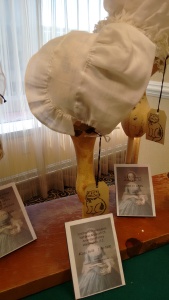[Draft 2 pics rev: . Sent to Nancy Davis 6.20.18. for comment. (she retired; forwarded to Bill Yeingst, chair of the division of Home and Community Life, at yeingstw@si.edu)]
Of the 100+ caps I’ve seen, only two are true “round-eared” caps. They are both from the Smithsonian collection, and from the same collection, the Copp Collection. They are cut out differently from one another. This one, Smiths 6608, has a rounded, pointed headpiece, and the ruffle curls around to meet it. The other, Smiths 6608B, has a straight headpiece.
The cap is housed in the textiles collection of the National Museum of American History.* The record for this item is not online.
The Original
The shiny, fine soft cloth of this cap is probably linen. The incredibly minute stitches are are not unusual in 18th C caps: I counted 20 stitches to the inch. Each edge is finished with a whip stitch, then the edges are butted together with another whip stitch. Together, the finished join is 1/16″ across! While not every cap was expertly made, most exhibit these precise, small, nearly perfect stitches. Every time I think, “I can do this now, look at those tiny stitches!” I see another example like this of period perfection, and despair.
There are 3 pieces:
- half-circle shaped caul with a gather tape that comes out of a split in the casing, CB.
- 2 1/4″ wide headpiece that rounds back to a point under the ear (thus the term, “round-eared cap,” I suppose.)
- 1 1/2″ ruffle, gathered only enough to get comfortably around that curve. The ruffle is whipped to the headpiece, but the front has a 1/8″ hem.
The museum dates this 1780-1800, partly because the Copp family artifacts include that era. As with many older collections, the curator who dated this item is no longer at the museum to ask what prompted the dates given. Nothing about it argues for a later date, and it looks like many caps seen in portraits of the period, so I accept this possibility.
Questions that remain
What don’t I understand? This cap is small, only 7 1/4″ high, which, once again, makes me wonder if the average 18th C head was smaller. In portraits, many round-eared caps are worn high on the head, with hair piled up inside, so maybe it isn’t intended to cover much ? Or were many extant caps actually made for younger women? We can’t tell a small adult cap from one made for a teenager.
And I always wonder why THIS cap made it through time for me to touch. Is this the souvenir saved from a child who died? Is this the failed cap that no one liked, so it sat unused? (I can hear the adolescent whine, “But, Ma, no one wears a cap like that anymore!”) Made at school for practice? Made by Grandma right before she passed away? Made by someone rich enough to have extra caps she didn’t need, found years later in some cupboard?
Round-eared caps are nearly as common in my sample of American period portraits as lappets. So why do we only have 2 examples? Did more of them get worn out? Perhaps because they tended to be worn by younger women? Or did I miss a trove of them when I couldn’t get to the Cooper-Hewitt?
Portraits

This portrait
of the Gordon Family shows Mrs. Gordon in a cap similar to this one. Most round-eared caps on portraits have a lot of gathers all around the cap, but here is one that seems less so. The date is 1763. The oldest daughter is wearing a cap like this, too, set very high on her head, so maybe the idea of small caps set high is accurate.
The Reproduction

I used the finest linen I had, but it isn’t as fine as the original. I didn’t manage to get my stitches as fine, either, especially the whipped edges. The thickness of the cloth does make tiny stitches harder. When I sew 20 stitches to the inch on a whipped edge, it often comes out stretched and tight like a dinosaur’s back.
Otherwise, I got the shape and proportions right.
My Notes :
smiths 6608 round notes and pattern
Thank Yous
Nancy Davis, Curator of Textiles at the Smithsonian’s National Museum of American History, helped me to identify items in that collection that were useful to this study. That was no small feat, as records were spread across several legacy cataloging systems, and details were minimal. I can only hope I found what there was to find!
Other Related Scholarship
I don’t know of any other scholarship concerning this cap.[
*. . . which is not the same thing as the Smithsonian’s Cooper Hewitt, in NYC. Their textiles section was under construction at the time of this study, so I didn’t get to see their artifacts.
Photos by the author.



One thought on “Rare Round-Eared Cap: Smiths 6608”